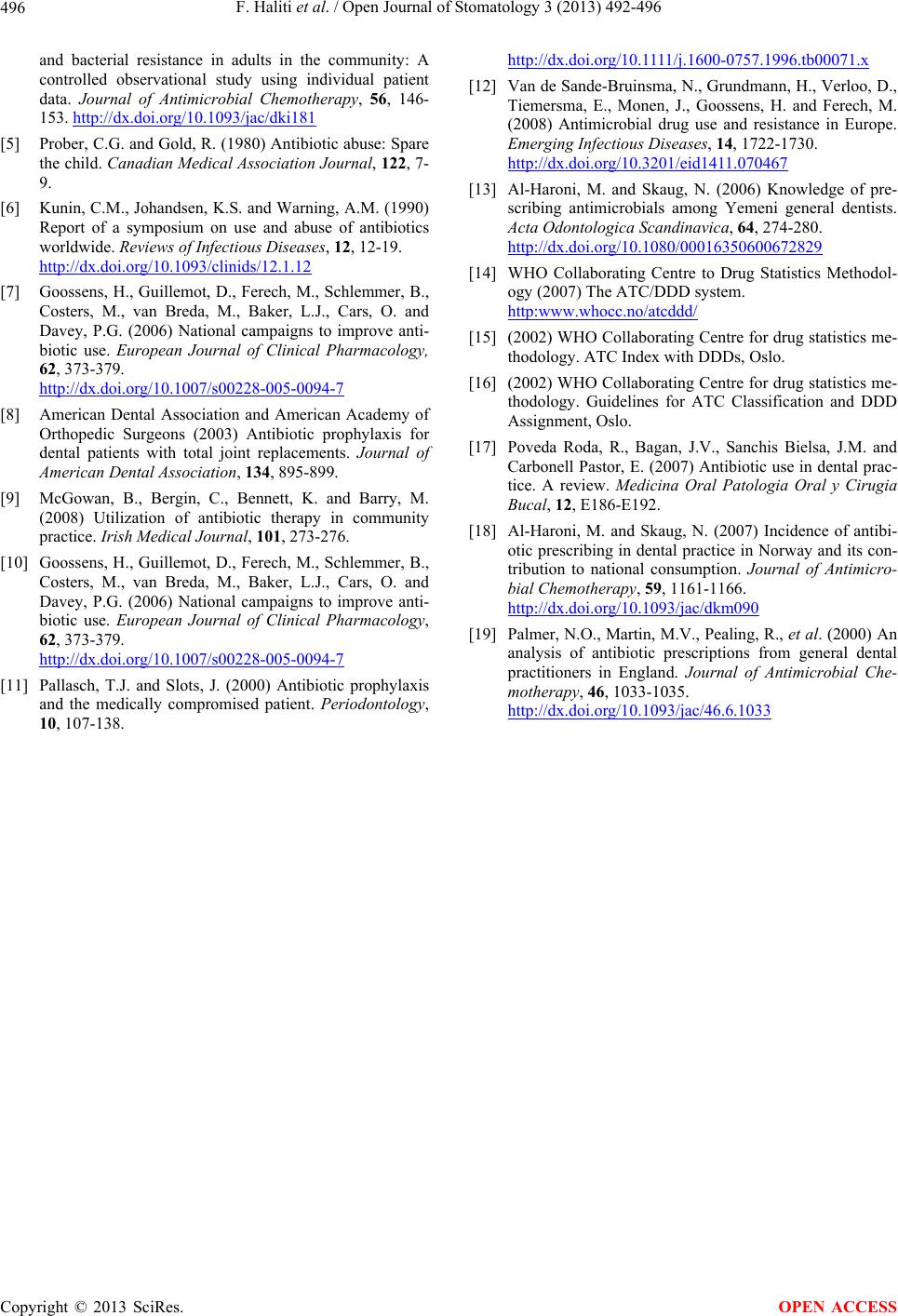
F. Haliti et al. / Open Journal of Stomatology 3 (2013) 492-496
496
and bacterial resistance in adults in the community: A
controlled observational study using individual patient
data. Journal of Antimicrobial Chemotherapy, 56, 146-
153. http://dx.doi.org/10.1093/jac/dki181
[5] Prober, C.G. and Gold, R. (1980) Antibiotic abuse: Spare
the child. Canadian Medical Association Journal, 122, 7-
9.
[6] Kunin, C.M., Johandsen, K.S. and Warning, A.M. (1990)
Report of a symposium on use and abuse of antibiotics
worldwide. Reviews of Infectious Diseases, 12, 12-19.
http://dx.doi.org/10.1093/clinids/12.1.12
[7] Goossens, H., Guillemot, D., Ferech, M., Schlemmer, B.,
Costers, M., van Breda, M., Baker, L.J., Cars, O. and
Davey, P.G. (2006) National campaigns to improve anti-
biotic use. European Journal of Clinical Pharmacology,
62, 373-379.
http://dx.doi.org/10.1007/s00228-005-0094-7
[8] American Dental Association and American Academy of
Orthopedic Surgeons (2003) Antibiotic prophylaxis for
dental patients with total joint replacements. Journal of
American Dental Associ ation, 134, 895-899.
[9] McGowan, B., Bergin, C., Bennett, K. and Barry, M.
(2008) Utilization of antibiotic therapy in community
practice. Irish Medical Journal, 101, 273-276.
[10] Goossens, H., Guillemot, D., Ferech, M., Schlemmer, B.,
Costers, M., van Breda, M., Baker, L.J., Cars, O. and
Davey, P.G. (2006) National campaigns to improve anti-
biotic use. European Journal of Clinical Pharmacology,
62, 373-379.
http://dx.doi.org/10.1007/s00228-005-0094-7
[11] Pallasch, T.J. and Slots, J. (2000) Antibiotic prophylaxis
and the medically compromised patient. Periodontology,
10, 107-138.
http://dx.doi.org/10 .1111/j.1600-0757.1996.tb00071.x
[12] Van de Sande-Bruinsma, N., Grundmann, H., Verloo, D.,
Tiemersma, E., Monen, J., Goossens, H. and Ferech, M.
(2008) Antimicrobial drug use and resistance in Europe.
Emerging Infectious Diseases, 14, 1722-1730.
http://dx.doi.org/10.3201/eid1411.070467
[13] Al-Haroni, M. and Skaug, N. (2006) Knowledge of pre-
scribing antimicrobials among Yemeni general dentists.
Acta Odontologica Scandinavica, 64, 274-280.
http://dx.doi.org/10.1080/00016350600672829
[14] WHO Collaborating Centre to Drug Statistics Methodol-
ogy (2007) The ATC/DDD system.
http:www.whocc.no/atcddd/
[15] (2002) WHO Collaborating Centre for drug statistics me-
thodology. ATC Index with DDDs, Oslo.
[16] (2002) WHO Collaborating Centre for drug statistics me-
thodology. Guidelines for ATC Classification and DDD
Assignment, Oslo.
[17] Poveda Roda, R., Bagan, J.V., Sanchis Bielsa, J.M. and
Carbonell Pastor, E. (2007) Antibiotic use in dental prac-
tice. A review. Medicina Oral Patologia Oral y Cirugia
Bucal, 12, E186-E192.
[18] Al-Haroni, M. and Skaug, N. (2007) Incidence of antibi-
otic prescribing in dental practice in Norway and its con-
tribution to national consumption. Journal of Antimicro-
bial Chemotherapy, 59, 1161-1166.
http://dx.doi.org/10.1093/jac/dkm090
[19] Palmer, N.O., Martin, M.V., Pealing, R., et al. (2000) An
analysis of antibiotic prescriptions from general dental
practitioners in England. Journal of Antimicrobial Che-
motherapy, 46, 1033-1035.
http://dx.doi.org/10.1093/jac/46.6.1033
Copyright © 2013 SciRes. OPEN ACCESS